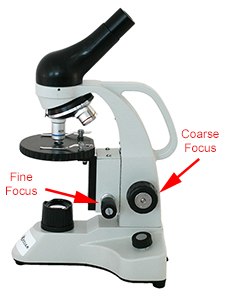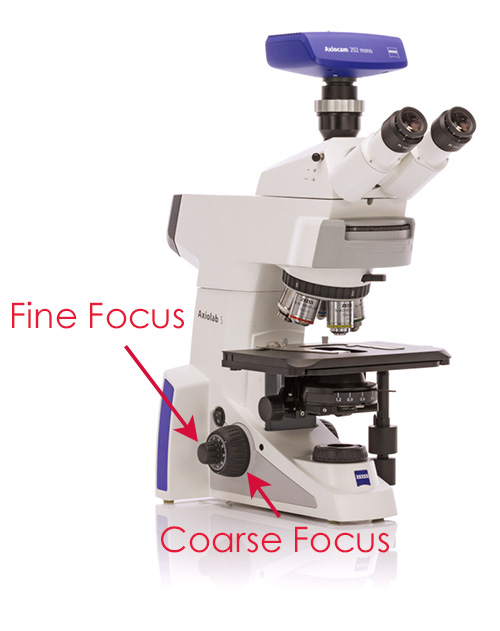Functions of Fine and Coarse Adjustment Knobs in Microscopes
Aug 13th 2023
Microscopes have revolutionized our ability to explore the world at an incredibly small scale, revealing intricate details that are otherwise invisible to the naked eye. One essential component of a microscope that plays a critical role in obtaining sharp, clear images is the fine adjustment knob. In this comprehensive guide, we delve into the function, importance, and techniques of the fine adjustment knob, shedding light on how this tiny mechanism helps researchers and students unlock the hidden wonders of the microcosm.
Understanding the Fine Adjustment Knob
 The fine adjustment knob is an integral part of a microscope's focusing system. It is typically located on the microscope's frame and works in tandem with the coarse adjustment knob. While the coarse adjustment knob facilitates initial focusing by rapidly moving the objective lens closer to or farther away from the specimen, the fine adjustment knob serves a more refined purpose. Its primary function is to fine-tune the focus of the microscope to achieve optimal clarity and detail. The fine focus knob is sometimes separate from the coarse focus knob, and sometimes it sits on top of the coarse focus knob.
The fine adjustment knob is an integral part of a microscope's focusing system. It is typically located on the microscope's frame and works in tandem with the coarse adjustment knob. While the coarse adjustment knob facilitates initial focusing by rapidly moving the objective lens closer to or farther away from the specimen, the fine adjustment knob serves a more refined purpose. Its primary function is to fine-tune the focus of the microscope to achieve optimal clarity and detail. The fine focus knob is sometimes separate from the coarse focus knob, and sometimes it sits on top of the coarse focus knob.
Importance of Fine Adjustment for Microscopy
Enhanced Precision: Achieving high-resolution images requires precise adjustments, and the fine adjustment knob enables researchers to make minute changes that can significantly impact image quality.
Clarity and Detail: When observing small or intricate structures, such as cellular components, the fine adjustment knob allows for delicate adjustments that help reveal finer details that might otherwise go unnoticed.
Minimizing Vibrations: Rapid adjustments using the coarse adjustment knob can introduce vibrations that blur the image. The fine adjustment knob's slow and controlled movements minimize these vibrations, leading to sharper images.

Using the Fine Adjustment Knob Effectively
Initial Coarse Adjustment: Before engaging the fine adjustment knob, it's essential to achieve a rough focus using the coarse adjustment knob. This ensures that you're in the right focal range to make precise adjustments.
Subtle Turns: The fine adjustment knob moves the objective lens only a fraction of a millimeter, so it's crucial to make subtle turns. Slowly rotate the knob in the direction that improves the focus, observing the changes through the eyepiece.
Both Eyes Open: When using a binocular microscope, keep both eyes open while adjusting the fine adjustment knob. This prevents eyestrain and allows you to monitor the changes in focus accurately.
Practice Patience: Achieving optimal focus may take time, especially when dealing with challenging samples. Be patient and don't rush the process to obtain the best results.
Benefits of the Fine Adjustment Knob in Different Fields
Biological Research: In biology, observing cellular structures demands exceptional clarity. The fine adjustment knob enables researchers to examine cells and tissues in minute detail, aiding in understanding their functions and interactions.
Medical Diagnosis: In the medical field, microscopes are indispensable for diagnosing diseases at the cellular level. The fine adjustment knob helps pathologists identify abnormalities and make accurate diagnoses.
Material Science: Microscopy is pivotal in material science, allowing researchers to analyze the properties of various materials. The fine adjustment knob enables them to explore the microstructure of materials and identify defects.
Education: In educational settings, the fine adjustment knob helps students develop microscopy skills. Learning to use this knob effectively is essential for budding scientists to explore the micro world accurately.
Function of the Coarse Adjustment Knob in Microscopes
The coarse adjustment knob on a microscope serves the essential function of rapidly adjusting the focus of the microscope's objective lens to bring the specimen into a rough focus range. This knob is larger and moves the objective lens in larger increments, making it suitable for quickly bringing the specimen into view and starting the focusing process. It helps researchers and students locate the specimen on the slide and get it roughly in focus before fine-tuning the focus using the fine adjustment knob.
The coarse adjustment knob is particularly useful when initially locating the specimen, changing magnification levels, or shifting focus between different specimens. Its larger movements allow for quick adjustments and help prevent the objective lens from coming into contact with the specimen or slide, which could damage both the microscope and the sample.
However, it's important to note that the coarse adjustment knob should be used cautiously, especially when working with high magnification objectives, to avoid potential damage to delicate specimens or objectives. Once the specimen is roughly in focus using the coarse adjustment knob, the fine adjustment knob should be employed to achieve a more precise and detailed focus, bringing out the finer structures and details of the specimen.
Some microscopes only have a coarse focus knob, and while this will work well for lower magnifications below 80x, when using higher magnifications it is best to use a microscope with both coarse and fine focusing.





